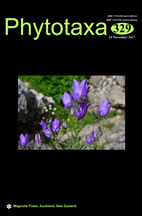Abstract
Phyllanthus polyphyllus Willdenow (1805: 586) is at present considered to be an accepted name applied for a species distributed in the peninsular India and Sri Lanka (e.g. Wight 1852, Thwaites 1861, Müller 1866, Hooker 1887, Trimen 1898, Gamble 1925, Webster 1997, Gangopadhyay et al. 2007, Chakrabarty et al. 2012). As regards Phyllanthus racemosus Linnaeus f. (1782: 415), it is at present considered to be a synonym of Synostemon bacciformis (L.) Webster (1960: 26), based on Phyllanthus bacciformis Linnaeus (1771: 294), according to the recent treatment by Van Welzen et al. (2014). However, it may be mentioned that it was Willdenow (1805: 582) who first misinterpreted P. racemosus by referring it to an Indian specimen (“Habitat in India orientali” – Klein s.n., B–W17973–010 [digital image!]), which is identifiable as Synostemon bacciformis. Later, Müller (1863) while describing Agyneia bacciformis (L.) Jussieu (1824: 24, t. 6) var. angustifolia cited P. racemosus as its synonym. Subsequently, Hooker (1887) and Pax & Hoffmann (1922) cited P. racemosus as a synonym of Agyneia bacciformis, while Van Welzen (2003) placed it as a synonym of Sauropus bacciformis (L.) Airy Shaw (1980: 685).

